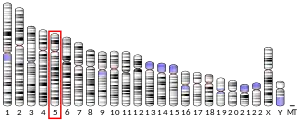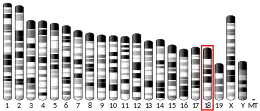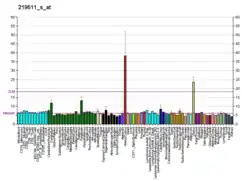SNCAIP
Synphilin-1 is a protein that in humans is encoded by the SNCAIP gene.[5][6] SNCAIP stands for "synuclein, alpha interacting protein" and can be signified by SNCAP_HUMAN, synphilin 1, synuclein, alpha interacting protein (synphilin), and SYPH1.
Function
This gene encodes a protein containing several protein-protein interaction domains, including ankyrin-like repeats, a coiled-coil domain, and an ATP/GTP-binding motif. The encoded protein interacts with alpha-synuclein in neuronal tissue and may play a role in the formation of cytoplasmic inclusions and neurodegeneration. A mutation in this gene has been associated with Parkinson's disease. Alternatively spliced transcript variants encoding different isoforms of this gene have been described, but their full-length nature has yet to be determined.[6]
The SNCAIP gene provides instructions for making a protein called synphilin-1 and a slightly different version of this protein called synphilin-1A. These proteins are produced in the brain. They are usually located in specialized structures called presynaptic terminals, found at the tips of nerve cells. In nerve cells, synphilin-1 and synphilin-1A interact with another protein called alpha-synuclein. The functions of synphilin-1 and synphilin-1A, however, are unknown.
Interactions
SNCAIP has been shown to interact with:
References
- GRCh38: Ensembl release 89: ENSG00000064692 - Ensembl, May 2017
- GRCm38: Ensembl release 89: ENSMUSG00000024534 - Ensembl, May 2017
- "Human PubMed Reference:". National Center for Biotechnology Information, U.S. National Library of Medicine.
- "Mouse PubMed Reference:". National Center for Biotechnology Information, U.S. National Library of Medicine.
- Engelender S, Kaminsky Z, Guo X, Sharp AH, Amaravi RK, Kleiderlein JJ, Margolis RL, Troncoso JC, Lanahan AA, Worley PF, Dawson VL, Dawson TM, Ross CA (May 1999). "Synphilin-1 associates with alpha-synuclein and promotes the formation of cytosolic inclusions". Nat Genet. 22 (1): 110–4. doi:10.1038/8820. PMID 10319874. S2CID 2611127.
- "Entrez Gene: SNCAIP synuclein, alpha interacting protein (synphilin)".
- Neystat M, Rzhetskaya M, Kholodilov N, Burke RE (June 2002). "Analysis of synphilin-1 and synuclein interactions by yeast two-hybrid beta-galactosidase liquid assay". Neurosci. Lett. 325 (2): 119–23. doi:10.1016/s0304-3940(02)00253-7. PMID 12044636. S2CID 11517781.
- Nagano Y, Yamashita H, Nakamura T, Takahashi T, Kondo E, Nakamura S (Dec 2001). "Lack of binding observed between human alpha-synuclein and Bcl-2 protein family". Neurosci. Lett. 316 (2): 103–7. doi:10.1016/s0304-3940(01)02330-8. PMID 11742726. S2CID 54363210.
- Kawamata H, McLean PJ, Sharma N, Hyman BT (May 2001). "Interaction of alpha-synuclein and synphilin-1: effect of Parkinson's disease-associated mutations". J. Neurochem. 77 (3): 929–34. doi:10.1046/j.1471-4159.2001.00301.x. PMID 11331421. S2CID 83885937.
- Chung KK, Zhang Y, Lim KL, Tanaka Y, Huang H, Gao J, Ross CA, Dawson VL, Dawson TM (October 2001). "Parkin ubiquitinates the alpha-synuclein-interacting protein, synphilin-1: implications for Lewy-body formation in Parkinson disease". Nat. Med. 7 (10): 1144–50. doi:10.1038/nm1001-1144. PMID 11590439. S2CID 12487644.
Further reading
- Krüger R (2005). "The role of synphilin-1 in synaptic function and protein degradation". Cell Tissue Res. 318 (1): 195–9. doi:10.1007/s00441-004-0953-z. PMID 15322916. S2CID 12186058.
- Engelender S, Wanner T, Kleiderlein JJ, Wakabayashi K, Tsuji S, Takahashi H, Ashworth R, Margolis RL, Ross CA (2000). "Organization of the human synphilin-1 gene, a candidate for Parkinson's disease". Mamm. Genome. 11 (9): 763–6. doi:10.1007/s003350010123. PMID 10967135. S2CID 22420090.
- Kawamata H, McLean PJ, Sharma N, Hyman BT (2001). "Interaction of alpha-synuclein and synphilin-1: effect of Parkinson's disease-associated mutations". J. Neurochem. 77 (3): 929–34. doi:10.1046/j.1471-4159.2001.00301.x. PMID 11331421. S2CID 83885937.
- Chung KK, Zhang Y, Lim KL, Tanaka Y, Huang H, Gao J, Ross CA, Dawson VL, Dawson TM (2001). "Parkin ubiquitinates the alpha-synuclein-interacting protein, synphilin-1: implications for Lewy-body formation in Parkinson disease". Nat. Med. 7 (10): 1144–50. doi:10.1038/nm1001-1144. PMID 11590439. S2CID 12487644.
- Ribeiro CS, Carneiro K, Ross CA, Menezes JR, Engelender S (2002). "Synphilin-1 is developmentally localized to synaptic terminals, and its association with synaptic vesicles is modulated by alpha-synuclein". J. Biol. Chem. 277 (26): 23927–33. doi:10.1074/jbc.M201115200. PMID 11956199.
- O'Farrell C, Pickford F, Vink L, McGowan E, Cookson MR (2002). "Sequence conservation between mouse and human synphilin-1". Neurosci. Lett. 322 (1): 9–12. doi:10.1016/S0304-3940(02)00068-X. PMID 11958831. S2CID 9654263.
- Neystat M, Rzhetskaya M, Kholodilov N, Burke RE (2002). "Analysis of synphilin-1 and synuclein interactions by yeast two-hybrid beta-galactosidase liquid assay". Neurosci. Lett. 325 (2): 119–23. doi:10.1016/S0304-3940(02)00253-7. PMID 12044636. S2CID 11517781.
- Junn E, Lee SS, Suhr UT, Mouradian MM (2003). "Parkin accumulation in aggresomes due to proteasome impairment". J. Biol. Chem. 277 (49): 47870–7. doi:10.1074/jbc.M203159200. PMID 12364339.
- Ihara M, Tomimoto H, Kitayama H, Morioka Y, Akiguchi I, Shibasaki H, Noda M, Kinoshita M (2003). "Association of the cytoskeletal GTP-binding protein Sept4/H5 with cytoplasmic inclusions found in Parkinson's disease and other synucleinopathies". J. Biol. Chem. 278 (26): 24095–102. doi:10.1074/jbc.M301352200. PMID 12695511.
- Ito T, Niwa J, Hishikawa N, Ishigaki S, Doyu M, Sobue G (2003). "Dorfin localizes to Lewy bodies and ubiquitylates synphilin-1". J. Biol. Chem. 278 (31): 29106–14. doi:10.1074/jbc.M302763200. PMID 12750386.
- Marx FP, Holzmann C, Strauss KM, Li L, Eberhardt O, Gerhardt E, Cookson MR, Hernandez D, Farrer MJ, Kachergus J, Engelender S, Ross CA, Berger K, Schöls L, Schulz JB, Riess O, Krüger R (2004). "Identification and functional characterization of a novel R621C mutation in the synphilin-1 gene in Parkinson's disease". Hum. Mol. Genet. 12 (11): 1223–31. doi:10.1093/hmg/ddg134. PMID 12761037.
- Scherzer CR, Jensen RV, Gullans SR, Feany MB (2004). "Gene expression changes presage neurodegeneration in a Drosophila model of Parkinson's disease". Hum. Mol. Genet. 12 (19): 2457–66. doi:10.1093/hmg/ddg265. PMID 12915459.
- Nagano Y, Yamashita H, Takahashi T, Kishida S, Nakamura T, Iseki E, Hattori N, Mizuno Y, Kikuchi A, Matsumoto M (2004). "Siah-1 facilitates ubiquitination and degradation of synphilin-1". J. Biol. Chem. 278 (51): 51504–14. doi:10.1074/jbc.M306347200. PMID 14506261.
- Tanaka M, Kim YM, Lee G, Junn E, Iwatsubo T, Mouradian MM (2004). "Aggresomes formed by alpha-synuclein and synphilin-1 are cytoprotective". J. Biol. Chem. 279 (6): 4625–31. doi:10.1074/jbc.M310994200. PMID 14627698.
- Lee G, Tanaka M, Park K, Lee SS, Kim YM, Junn E, Lee SH, Mouradian MM (2004). "Casein kinase II-mediated phosphorylation regulates alpha-synuclein/synphilin-1 interaction and inclusion body formation". J. Biol. Chem. 279 (8): 6834–9. doi:10.1074/jbc.M312760200. PMID 14645218.
- Chung KK, Thomas B, Li X, Pletnikova O, Troncoso JC, Marsh L, Dawson VL, Dawson TM (2004). "S-nitrosylation of parkin regulates ubiquitination and compromises parkin's protective function". Science. 304 (5675): 1328–31. doi:10.1126/science.1093891. PMID 15105460. S2CID 86854030.





